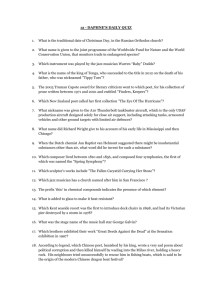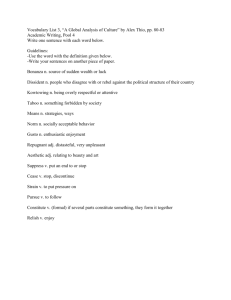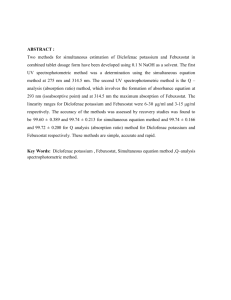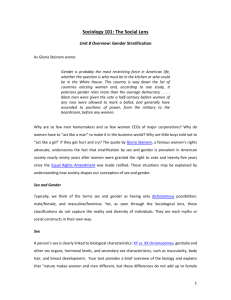Document 13308512
advertisement
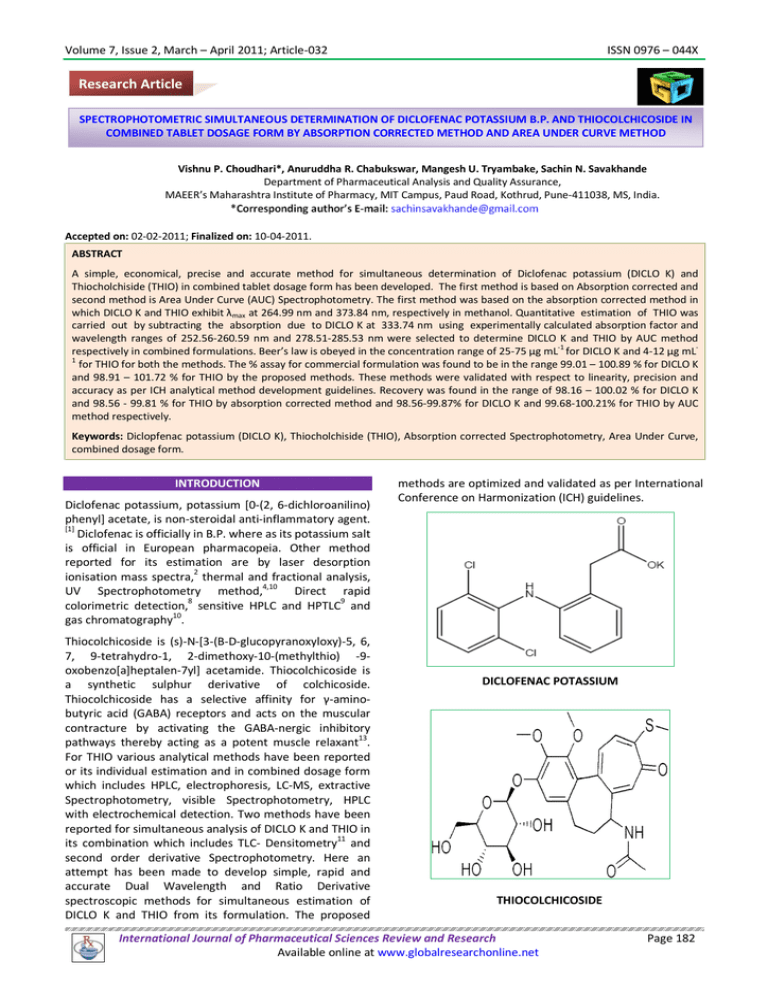
Volume 7, Issue 2, March – April 2011; Article-032 ISSN 0976 – 044X Research Article SPECTROPHOTOMETRIC SIMULTANEOUS DETERMINATION OF DICLOFENAC POTASSIUM B.P. AND THIOCOLCHICOSIDE IN COMBINED TABLET DOSAGE FORM BY ABSORPTION CORRECTED METHOD AND AREA UNDER CURVE METHOD Vishnu P. Choudhari*, Anuruddha R. Chabukswar, Mangesh U. Tryambake, Sachin N. Savakhande Department of Pharmaceutical Analysis and Quality Assurance, MAEER’s Maharashtra Institute of Pharmacy, MIT Campus, Paud Road, Kothrud, Pune-411038, MS, India. Accepted on: 02-02-2011; Finalized on: 10-04-2011. ABSTRACT A simple, economical, precise and accurate method for simultaneous determination of Diclofenac potassium (DICLO K) and Thiocholchiside (THIO) in combined tablet dosage form has been developed. The first method is based on Absorption corrected and second method is Area Under Curve (AUC) Spectrophotometry. The first method was based on the absorption corrected method in which DICLO K and THIO exhibit λmax at 264.99 nm and 373.84 nm, respectively in methanol. Quantitative estimation of THIO was carried out by subtracting the absorption due to DICLO K at 333.74 nm using experimentally calculated absorption factor and wavelength ranges of 252.56-260.59 nm and 278.51-285.53 nm were selected to determine DICLO K and THIO by AUC method -1 respectively in combined formulations. Beer’s law is obeyed in the concentration range of 25-75 µg mL for DICLO K and 4-12 µg mL 1 for THIO for both the methods. The % assay for commercial formulation was found to be in the range 99.01 – 100.89 % for DICLO K and 98.91 – 101.72 % for THIO by the proposed methods. These methods were validated with respect to linearity, precision and accuracy as per ICH analytical method development guidelines. Recovery was found in the range of 98.16 – 100.02 % for DICLO K and 98.56 - 99.81 % for THIO by absorption corrected method and 98.56-99.87% for DICLO K and 99.68-100.21% for THIO by AUC method respectively. Keywords: Diclopfenac potassium (DICLO K), Thiocholchiside (THIO), Absorption corrected Spectrophotometry, Area Under Curve, combined dosage form. INTRODUCTION Diclofenac potassium, potassium [0-(2, 6-dichloroanilino) phenyl] acetate, is non-steroidal anti-inflammatory agent. [1] Diclofenac is officially in B.P. where as its potassium salt is official in European pharmacopeia. Other method reported for its estimation are by laser desorption ionisation mass spectra,2 thermal and fractional analysis, UV Spectrophotometry method,4,10 Direct rapid colorimetric detection,8 sensitive HPLC and HPTLC9 and gas chromatography10. Thiocolchicoside is (s)-N-[3-(B-D-glucopyranoxyloxy)-5, 6, 7, 9-tetrahydro-1, 2-dimethoxy-10-(methylthio) -9oxobenzo[a]heptalen-7yl] acetamide. Thiocolchicoside is a synthetic sulphur derivative of colchicoside. Thiocolchicoside has a selective affinity for γ-aminobutyric acid (GABA) receptors and acts on the muscular contracture by activating the GABA-nergic inhibitory pathways thereby acting as a potent muscle relaxant13. For THIO various analytical methods have been reported or its individual estimation and in combined dosage form which includes HPLC, electrophoresis, LC-MS, extractive Spectrophotometry, visible Spectrophotometry, HPLC with electrochemical detection. Two methods have been reported for simultaneous analysis of DICLO K and THIO in its combination which includes TLC- Densitometry11 and second order derivative Spectrophotometry. Here an attempt has been made to develop simple, rapid and accurate Dual Wavelength and Ratio Derivative spectroscopic methods for simultaneous estimation of DICLO K and THIO from its formulation. The proposed methods are optimized and validated as per International Conference on Harmonization (ICH) guidelines. DICLOFENAC POTASSIUM THIOCOLCHICOSIDE International Journal of Pharmaceutical Sciences Review and Research Available online at www.globalresearchonline.net Page 182 Volume 7, Issue 2, March – April 2011; Article-032 MATERIALS AND METHODS Instrumentation An UV-Visible double beam spectrophotometer (Varian Cary 100) with 10 mm matched quartz cells was used. All weighing were done on electronic balance (Model Shimadzu AUW-220D). ISSN 0976 – 044X Corrected Absorbance of THIO at 373.84nm = abs333.74 (DICLO K +THIO) – [(abs373.84 (DICLO K)/ abs264.99 (DICLO K)] × abs264.99 (DICLO K) or Corrected Absorbance of THIO at 373.84nm = abs373.84 (DICLO K +THIO) – 1.152 × abs264.99 (DICLO K) Where; abs: Absorption value at given wavelengths. Method B: Area under Curve Reagents and chemicals Pure drug sample of DICLO K and THIO were kindly supplied as a gift sample by Zest Pharma, Indore and Glenmark Pharmaceuticals, Sinner, Nasik, respectively. These samples were used without further purification. Tablet formulation manufactured by Sun Pharmaceutical Industries (Lotensyl, Batch No. AD 92286) was purchased from local market containing DICLO K (50 mg) and THIO (10 mg) per tablet. Spectroscopic grade methanol purchased from Merck, Mumbai was used throughout the study. Theoretical aspects Method A: Absorption Corrected Method λmax of DICLO K and THIO was determined by scanning the drug solution in methanol was found to be at 264.99 nm and 373.84 nm respectively. DICLO K also showed absorbance at 373.84 nm, while THIO did not show any interference at 264.99 nm. To construct Beer’s plot for DICLO K and THIO dilutions were made in the solvent using stock solution of 1000 µg/ml. Also Beer’s plot was constructed for DICLO K and THIO in solution mixture at different concentration (25:4, 37.5:6, 50:8, 62.5:10, 75:12 µg/ml) levels. Both the drugs followed linearity individually and in mixture within the concentration range 25-75 µg/ml and 4-12 µg/ml for DICLO K and THIO respectively (Fig.1). Figure 1: Overlain zero order absorbance spectra of DICLO K (6 µg/mL) and THIO (12 µg/mL) For the simultaneous determination using the area under the curve method, suitable dilutions of the standard stock solutions (1000 µg/ml) of DICLO K and THIO were prepared separately in methanol. The solutions of drugs were scanned in the range of 200-450 nm. For Area Under Curve method, the sampling wavelength ranges selected for estimation of DICLO K and THIO are 252.56260.59 nm (λ1-λ2) and 278.51-285.53 nm (λ3-λ4). Mixed standard were prepared and their Area under the Curve were measured at the selected wavelength ranges. Concentration of two drugs in mixed standard and the sample solution were calculated using equation (1) and (2). A1 = 2253.33 CATO + 3031.25 CTHIO………. (1) at 243-248nm. A2 = 1502.33 CATO + 5566.58 CTHIO............. (2) at 291.08299.86 nm. Where, 2253.33 and 1502.33 are absortivities of DICLO K at (λ1λ2) and (λ3-λ4) respectively. 3031.25 and 5566.58 are absortivities of THIO at (λ1-λ2) and (λ3-λ4) respectively. A1 and A2 are absorbances of mixed standard at (λ1-λ2) and (λ3-λ4) respectively. CDICLOK and CTHIO are the concentrations in g/100mL. Figure 2: Overlay spectrum of THIO and DICLO K Selected Preparation of Standard Stock Solutions and calibration Curve DICLO K and THIO solution in methanol of known concentrations were scanned against blank on spectrophotometer. The value of absorption factor was found to be 1.152. Quantitative estimation of DICLO K and THIO was carried out using following equation: Standard stock solutions of pure drug containing 1000 µg mL-1 of DICLO K and THIO were prepared separately in methanol. The working standard solutions of these drugs were obtained by dilution of the respective stock solution in methanol. Derivative amplitudes of spectrum, by using the above mentioned procedure, were Determination Wavelengths of Absorption Factor at International Journal of Pharmaceutical Sciences Review and Research Available online at www.globalresearchonline.net Page 183 Volume 7, Issue 2, March – April 2011; Article-032 ISSN 0976 – 044X used to prepare calibration curves for both the drugs. Beer’s law obeyed in the concentration range of 25-75 µg mL-1 for DICLO K and 4-12 µg mL-1 for THIO for ratio derivative and AUC spectroscopic methods respectively. Preparation of Sample Stock Solution and Formulation analysis Twenty tablets were weighed accurately and a quantity of tablet powder equivalent to 50 mg of DICLO K (8 mg of THIO) was weighed and dissolved in the 40 mL of methanol with the aid of ultrasonication for 15 min and solution was filtered through Whatman paper No. 41 into a 50 mL volumetric flask. Filter paper was washed with methanol, adding washings to the volumetric flask and volume was made up to mark. The solution was suitably diluted with methanol to get of 37.5µg mL-1 of -1 DICLO K and 6 µg mL of THIO Recovery studies The accuracy of the proposed methods was checked by recovery study, by addition of standard drug solution to preanalysed sample solution at three different concentration levels (50 %, 100 % and 150 %) within the range of linearity for both the drugs. The basic concentration level of sample solution selected for spiking of the drugs standard solution was 37.5 µg/ml of DICLO K and 6 µg/ml of THIO for both the methods. Precision of the Method Reparability of the methods was studied by repeating the methods six times. To study intra-day precision, method was repeated 3 times in a day. Similarly the method was repeated on five different days to determine inter-day precision. RESULTS AND DISCUSSION The proposed methods for simultaneous estimation of DICLO K and THIO in combined dosage form were found to be accurate, simple and rapid. Since none of the method is reported for simultaneous analysis of the two drugs earlier, the developed methods can be used for routine analysis of two drugs in combined dosage forms. Method A Practically no interference from tablet excipients was observed in these methods. As their λmax differ more than 20 nm, absorption corrected method was tried for their simultaneous estimation in formulation. Quantitative estimation of THIO was carried out by subtracting interference of DICLO K using experimentally calculated absorption factor. Method B involves formation and solving of simultaneous equation. Once the equations are formed, then only measurement of the area of sample solution at two wavelength ranges and simple calculations are required. Table 1: Optical characteristics of the proposed methods Diclofenac potassium Method A Method B 264.99 252.56-260.59 Parameter λ (nm) -1 Beer’s law limit (µg mL ) 25 – 75 4 - 12 25-75 4 – 12 Slope (m) 0.02204 - 0.02646 - Intercept (c) -0.03232 - -0.0267 - 0.9993 0.68 1.10 1.24 0.76 0.78 0.95 0.9998 0.59 0.67 0.87 0.82 1.40 0.83 Formulation - I 99.01, 0.89 98.91, 1.1 100.89, 0.56 101.72, 1.04 Formulation - II 100.11, 0.63 99.24, 0.93 99.84, 0.75 101.5, 0.62 Regression Equation (y = mx + c) Correlation coefficient Repeatability (n=5) Precision Intra-day (3x3) (%R.S.D.) Inter-day(3x3) Formulation Analysis (% Assay, %RSD) n=6 Level Recovery of Formulation I DICLO K 80% THIO Result of recovery study Thiocolchicoside Method A Method B 373.84 278.51- 285.53 DICLO K 100% THIO DICLO K 120% THIO Amount (µg/mL) Spiked Recovered 2.4 2.400 % Mean Recovery (n=3) 100.02 % R.S.D. 0.52 Formulation II 2.4 2.379 99.12 1.2 Formulation I Formulation II Formulation I 4.8 4.8 3 4.731 4.765 2.945 98.56 99.27 98.16 0.05 0.95 1.92 Formulation II 3 2.972 99.06 1.5 Formulation I Formulation II 6 6 5.968 6.012 99.46 100.2 0.79 0.97 Formulation I Formulation II Formulation I Formulation II 3.6 3.6 7.2 7.2 3.581 3.579 7.187 7.166 99.47 99.41 99.81 99.52 1.03 1.57 0.19 1.34 R.S.D. is relative standard deviation International Journal of Pharmaceutical Sciences Review and Research Available online at www.globalresearchonline.net Page 184 Volume 7, Issue 2, March – April 2011; Article-032 A critical evaluation of proposed method was performed by statistical analysis of data where slope, intercept, correlation coefficient is shown in Table 1. As per the ICH guidelines, the method validation parameters checked were linearity, accuracy and precision. Beer’s law obeyed in the concentration range 25-75 µg mL-1 for DICLO K and 4-12 µg mL-1 for THIO with correlation coefficient of > 0.999 for both the drugs. For DICLO K, the recovery study results ranged from 98.16 – 100.02 % and 98.56 - 99.81 for THIO by Absorption corrected method and 98.5699.87% for DICLO K and 99.68-100.21% for THIO by AUC method respectively. Results of recovery studies are also shown in Table 1. The accuracy and reproducibility is evident from the data as results are close to 100 % and standard deviation is low. ISSN 0976 – 044X Sodium in capsule dosage form, J. Chem. Pharm. Res., 2010, 2, 186-196. 5. Y. K. Agrawal and K. Shivramchandras, Spectrophotometric determination of diclofenac sodium in tablets, Journal of Pharmaceutical & Biomedical Analysis, 9, 2, 1991, 97-100. 6. Ming-Thau Sheu, Huei-Lan Chou, Ching-Cheng Kao, Cheng-Hsiung Liu, Theodore D. Sokoloski, Dissolution of diclofenac sodium from matrix tablets , International Journal of Pharmaceutics, 85, 1992, 5763. 7. British Pharmacopoeia, London: stationary office, 2004, I: 626. 8. M.S. Bhatia, S.R. Dhaneshwar, Simple colorimetric detection of diclofenac sodium from tablets. 9. M.Riegel, P.P. Ellis, High-performance liquid chromatographic assay for antiinflammatory agents diclofenac and flurbiprofen in ocular fluids, Journal of Chromatography B, 654, 1994, 140-145. CONCLUSION The validated spectrophotometric methods employed here proved to be simple, economical, precise and accurate. Thus, it can be used as IPQC test and for routine simultaneous determination of DICLO K and THIO in tablet dosage form. Acknowledgement: The authors wish to express their gratitude to Litaka Pharmaceuticals Pune, India, for providing sample of pure Diclofenac potassium and Thiocolchicoside. The authors are also thankful to the management of MAEER’s Maharashtra Institute of Pharmacy for providing necessary facilities. REFERENCES 1. Julio c. Botello and guadalupe pi~rez-caballero*, spectrophotometric determination of Diclofenac sodium with methylene blue, Talanta, 42, 1995, 105108. 2. Gao, Songmei, Analysis of diclofenac potassium by laser desorption ionization mass spectrum. 3. The Merck index, an encyclopedia of chemicals, drugs & Biologicals, Merck research laboratories, 13th ed., 1997, 3108,9397. 4. R. K. Prasad and R.Sharma, Simultaneous estimation and validation of Rabeprazole Sodium and Diclofenac The Majesty 10. W. Schneider, P.H. Degen, Simultaneous determination of diclofenac sodium and its hydroxy metabolites by capillary column gas chromatography with electron-capture detection, Journal of Chromatography A, 217, 1981, 263-271. 11. N. A. El-Ragehy, M. M. Ellaithy, M. A. El-Ghobashy, Determination of thiocolchicoside in its binary mixtures (Thiocolchicoside glafenine and Thiocolchicoside-floctafenine) by TLC-densitometry, 58, 2003, 463-468. 12. A.H. Beckett, J.B. Stenlake, Practical pharmaceutical chemistry, the Athlone press of university of London, 3rd ed., part two, 1976, 249. 13. M. Carta, L. Murru, P. Botta, G.Talani, G. Pietro Sechi, P. De Riu, E. Sanna, G. Biggio, The muscle relaxant thiocolchicoside is an antagonist of GABAA receptor function in the central nervous system, Neuropharmacology 51, 2006, 805-815. *************** International Journal of Pharmaceutical Sciences Review and Research Available online at www.globalresearchonline.net Page 185
